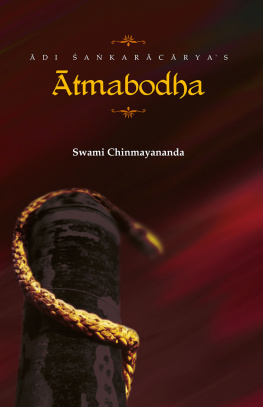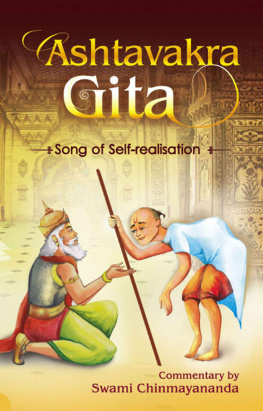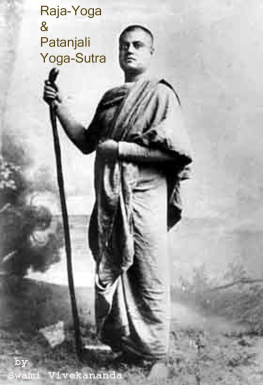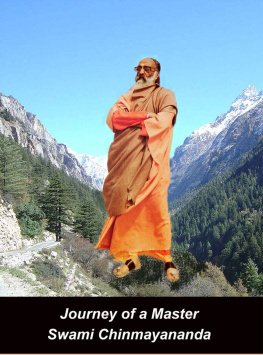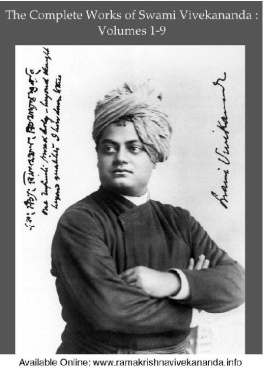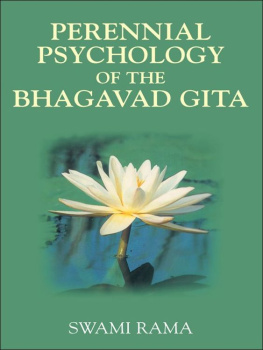Swami Chinmayananda - ATMABODHA
Here you can read online Swami Chinmayananda - ATMABODHA full text of the book (entire story) in english for free. Download pdf and epub, get meaning, cover and reviews about this ebook. year: 2017, publisher: Central Chinmaya Mission Trust, genre: Religion. Description of the work, (preface) as well as reviews are available. Best literature library LitArk.com created for fans of good reading and offers a wide selection of genres:
Romance novel
Science fiction
Adventure
Detective
Science
History
Home and family
Prose
Art
Politics
Computer
Non-fiction
Religion
Business
Children
Humor
Choose a favorite category and find really read worthwhile books. Enjoy immersion in the world of imagination, feel the emotions of the characters or learn something new for yourself, make an fascinating discovery.
- Book:ATMABODHA
- Author:
- Publisher:Central Chinmaya Mission Trust
- Genre:
- Year:2017
- Rating:5 / 5
- Favourites:Add to favourites
- Your mark:
- 100
- 1
- 2
- 3
- 4
- 5
ATMABODHA: summary, description and annotation
We offer to read an annotation, description, summary or preface (depends on what the author of the book "ATMABODHA" wrote himself). If you haven't found the necessary information about the book — write in the comments, we will try to find it.
ATMABODHA — read online for free the complete book (whole text) full work
Below is the text of the book, divided by pages. System saving the place of the last page read, allows you to conveniently read the book "ATMABODHA" online for free, without having to search again every time where you left off. Put a bookmark, and you can go to the page where you finished reading at any time.
Font size:
Interval:
Bookmark:


Chinmaya Prakashan
The Publications Division of
Central Chinmaya Mission Trust
Sandeepany Sadhanalaya
Saki Vihar Road, Powai, Mumbai 400072, India
Tel.: +91-22-2803 4900
Email:
Website: www.chinmayamission.com
Chinmaya Mission West
Publications Division
560 Bridgetown Pike
Langhorne, PA 19053, USA
Tel.: 1-888-CMW-READ, (215) 396-0390 Fax: (215) 396-9710
Email:
Website: www.chinmayapublications.org
Chinmaya Kalpanam, Mumbai
Chinmaya Digital Media, Mumbai
Preface
CCMT is delighted to present before its readers the revised edition of tmabodha with a revamped cover and layout, thus meeting a longstanding demand. We have also attempted to eliminate all errors and have incorporated diacriticals making the book as reader-friendly as possible.
tmabodha is an introductory text to Vednta. di akarcrya as a poet has succeeded in painting the ideals of Vednta not only with beautiful examples and similes but also with logical explanations.
Pjya Gurudev Swami Chinmayananda takes us on a journey of spiritual wisdom by expounding this text in modern day terms and for the common mans understanding.
We thank Chinmaya Prakashanam and Chinmaya Kalpanam team for the efforts they have taken to bring out this beautiful book.
We are positive that the readers will benefit from reading and reflecting upon the wise words of the Masters.
Central Chinmaya Mission Trust
Mumbai - 400 072

Transliteration and Pronunciation Guide
In the book, Devangar characters are transliterated according to the scheme adopted by the International Congress of Orientalists at Athens in 1912. In it one fixed pronunciation value is given to each letter; f, q, w, x and z are not called to use. According to this scheme:

Introduction
No scientif ic textbook can be prescribed to the students without an initial chapter giving the definition of the terms and terminologies that are used in the body of the book. The scientist visualises the world from his viewpoint, he sees those facts and truths which are not visible to others. Since he sees visions which are not the common property of all, in his language he will have to use unconventional words which have for him some special imports and secret suggestions. If these extraordinary words are not rightly understood by the teacher and the taught, transfer of knowledge would be impossible. Therefore, in every textbook of science, the first few chapters describe the categories.
Sufferings and sorrows form a part of lifes games. There is none who has not undergone pressing agonies in his own day-to-day life, either physically, mentally or emotionally. Yet, nobody seems to invite them. In fact whatever we do is to avoid, as far as possible, this aspect of life coming in contact with us. The more we want to escape its cruel jaws, the more it takes an endless variety of subtler and sharper ways of attacking.
Physical ailments form but one tribe of hordes that barbarously attack us; even more relentless and cruel are our mental sufferings. As we progress in our knowledge of the curative processes for ameliorating the physical sufferings, we observ e that the minds ill health affects the body much more than what one could imagine; and this kind of suffering proves all the more difficult to deal with. Mental disintegration is more dangerous, for it brings about not only misery to the sufferer but also a kind of dangerous disharmony in and excruciating intolerance with the surroundings of such an individual.
On the whole, it means that each one of us who is suffering (and is there anyone who is not?) from this inner malady is an unhappy centre, spreading unhappiness and restlessness all around oneself. A solution to these problems, very complicated and extremely confusing to the average mind, is what we seek individually and collectively. The results of such investigations conducted by the ancient is and the data collected from their personal experiences constitute the bulk of our scriptures.
Today, instead of searching for any radical solution and specific cure for this problematic disease and consequent suffering in life, what man actually does in society is to collect around him various kinds of escape distractions and compromise dopes, through all kinds of foul methods. He vainly hopes to drown his sorrows in ever so many unhealthy indulgences. By these methods, at best man succeeds in turning his mind away from the actual facts of life as they are. To analyse scientifically and to observe closely, the nature and behaviour of our outer world of objects and the inner instruments of experience in us are the methods employed in the Upaniads, by which the seers have discovered a happy solution for the great problems of man and his life.
Vednta is the science of life. It explains the art of living. It points out the ultimate goal of existence and provides schemes and methods by which sincere seekers can easily make their pilgrimage successful. Since the Teacher has to point out a goal transcending the ordinary realms of experiences, he has to borrow his vocabulary from the everyday language and present them, no doubt, strangely dressed up in special significances. Naturally, the obvious dictionary meaning will not be a true guide in digesting and assimilating the declarations of the scriptures.
The golden key, by which the scriptures are opened and its divine Knowledge brought out, is found in the books like tmabodha , which explains exhaustively the categories in Vednta. Such volumes are known as the prakaraa granthas.
Knowledge available in the world of books is found in two types of records textbooks of the science explaining the theory and technique are known as the stras and the books that explain the terms and terminologies used in the stras are known as the prakaraa granthas. Pacada, Vivekacmai, Tattvabodha, tmabodha are some of the examples of the latter type of books. They explain the stras but they do not contribute any original thought.
r akara took upon himself as his lifes great mission, the reorientation of Hinduism. After having written his commentaries upon the sacred books of our culture, he provided the seekers with a voluminous devotional literature, singing his own love of the Lord. In the days of his perfect maturity, he took up his pen to write introductory books, introducing the theme of Vednta for the infants in the spiritual world. tmabodha is one of them. This is not an original book inasmuch as there is not a single idea in it which is an entirely original contribution of r akara. Everyone of them is culled from the garden of the Upaniads and strung together on the chord of his poetry, interspersed with his exquisite simile. This wonderful garland so offered by akara to adorn Mother uti is tmabodha .
As a modern materialistic man comes to study more and more the contents of the Upaniads, it is possible that he feels cheated of the cheaper joys of his previous easier life of mental distraction and physical dissipations. This negative feeling of a nameless sad regret saps all enthusiasm in the student. But this feeling comes only so long as one has not fully realised the fact that the enchanting fascinations of usual broadway distractions have a knack of wearing away too soon; one gets quickly bored of such superficialities.
Next pageFont size:
Interval:
Bookmark:
Similar books «ATMABODHA»
Look at similar books to ATMABODHA. We have selected literature similar in name and meaning in the hope of providing readers with more options to find new, interesting, not yet read works.
Discussion, reviews of the book ATMABODHA and just readers' own opinions. Leave your comments, write what you think about the work, its meaning or the main characters. Specify what exactly you liked and what you didn't like, and why you think so.

